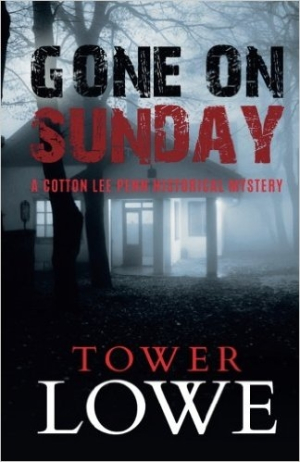Gone on Sunday
Gone on Sunday mixes the light touch of a cozy mystery, the terrible weight of history, a hint of romance, and the secrets of stifling summer.
In Tower Lowe’s delicious and sultry Gone on Sunday, a forty-year-old murder mystery remains unsolved, affecting the life of every citizen of the tiny town of Homeville, Virginia. Eccentric characters, family histories, and the racial tumult that burns under a layer of sweet southern charm interact in a captivating way with lifelong lies, fears, abuse, and love.
In 1932, Bead Baker, a white woman, is beaten to death in her kitchen. Suspicions abound as to the identity of the culprit. In a terrifying yet understated sequence, the son of Bead’s black maid is lynched for the murder by vigilantes wearing hoods and sheets, but no one is ever duly tried and convicted of the crime.
Forty years later, Bead’s granddaughter, Little Mary Peebles, is murdered in much the same manner as Bead. Town lawyer Max Mayfair hires Little Mary’s cousin, Cotton Lee Penn, a feisty young woman with a post-polio limp. Together they attempt to find the killer and protect Max’s client, the murdered woman’s fiancé. Cotton Lee is convinced the 1932 murder is related to the current one.
Chapters alternate between the two time periods. Each is told from the point of view of a different character, thus digging deeply into the motivations, relationships, histories, and family arguments boiling beneath the town’s polite surface. Early chapters foreshadow later action, later chapters shed light on what happened before, and all chapters except the very last one end with compelling and well-earned cliffhangers.
Each character holds multiple secrets, and revelations are doled out bit by bit through memories, dialogue, and skillful exposition. Ingenious description (“Heat baked off the grass and bent the air like a carnival mirror”) gives a sensuous impression of the insular world of Homeville, with its decaying Southern mansions and empty, sunburned downtown.
Even though there are a lot of people and relationships to follow, it’s easy to keep track of who’s who. The idiosyncratic characters think, speak, and move in their own particular ways. Although the defiant and pertinacious Cotton Lee is the clear protagonist, each character is worthy of starring in their own book.
Of the novel’s many enjoyable features, the plot is one of the most intriguing. Mysteries intertwine with the complexity of an elegant tapestry—each strand is deftly introduced, woven through, and solved. Each character has a history with every other, spanning the decades and surfacing naturally and surprisingly as the story unfolds.
With nary a mint julep or other southern cliché to be found, Gone on Sunday mixes the light touch of a cozy mystery, the terrible weight of history, a hint of romance, and the secrets of stifling summer to engrossing and highly entertaining effect. The result is a historical mystery combined with a modern one, satisfying on every level.
Reviewed by
Petrea Burchard
Disclosure: This article is not an endorsement, but a review. The publisher of this book provided free copies of the book and paid a small fee to have their book reviewed by a professional reviewer. Foreword Reviews and Clarion Reviews make no guarantee that the publisher will receive a positive review. Foreword Magazine, Inc. is disclosing this in accordance with the Federal Trade Commission’s 16 CFR, Part 255.

